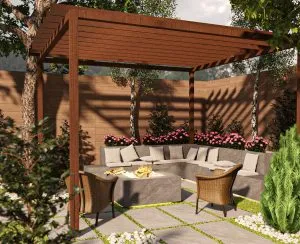Are you considering an outdoor gazebo? There are a variety of materials to consider when choosing a gazebo for your outdoor space. Wood gazebos and aluminum gazebos are the mainstream on the market. Wood gazebos are elegant and textured, while aluminum gazebos have modern and stylish styles and low maintenance features. Let’s explore the differences between them in detail to help you make an informed decision.

Durability and Maintenance
Wooden Gazebos
Durability: Wood is a strong and durable material, but it is susceptible to rot, insects, and weather damage over time.
Maintenance: Wooden gazebos require regular maintenance, such as staining or painting, to protect against moisture, UV rays, and pests. This can be time-consuming and expensive.
Aluminum Gazebos
Durability: Aluminum is highly resistant to rust, corrosion, and weather damage. It is a strong material that can withstand harsh conditions without deteriorating.
Maintenance: Aluminum gazebos are low-maintenance and require only occasional cleaning to keep them looking their best. They do not require painting or staining.

Aesthetics and Customization
Wooden Gazebos
Aesthetics: Wood has a classic, natural look that blends seamlessly with the outdoors. It provides a warm and inviting feel.
Customization: Wooden gazebos can be easily customized with different stains, paints, and designs. They offer a high degree of flexibility in aesthetic choices.
Aluminum Gazebos
Aesthetics: Aluminum gazebos have a sleek, modern look. They can mimic other materials like wood with a variety of finishes and coatings.
Customization: While aluminum gazebos offer fewer customization options than wood, it still offers a variety of design options and finishes to suit different styles.

Environmental Impact
Wooden Gazebos
Sustainability: Wood can be a sustainable material if sourced properly. However, the environmental impact depends on the type of wood and forest management practices.
Eco-Friendly: Wood structures are biodegradable, which can reduce long-term environmental impact if not treated with harmful chemicals.
Aluminum Gazebos
Sustainability: Aluminum is a recyclable material, making it an eco-friendly choice. Recycling aluminum saves energy and resources compared to producing new aluminum.
Environmentally friendly: Aluminum production has a significant impact on the environment, but its long life and recyclability can offset this impact.

Costs
Wooden
Initial Cost: Depending on the type of wood used, a wooden gazebo may have a lower initial cost than an aluminum gazebo. If you are looking for a more aesthetically pleasing and high-value look, the cost of a wooden gazebo will become higher.
Long-term Costs: Maintenance costs, including disposal and repairs, will increase over time, making a wooden gazebo more expensive in the long run.
Aluminum
Initial Cost: Aluminum gazebos tend to have a higher upfront cost due to the materials and manufacturing process.
Long-term Cost: Aluminum gazebos can be more cost-effective over time due to low maintenance costs and longer lifespan.

Conclusion
Both wooden and aluminum gazebos have their own advantages and disadvantages. Wooden gazebos have a traditional, customizable look, but require regular maintenance. Aluminum gazebos have a modern aesthetic, durability, and low maintenance, but the initial cost is higher. Considering the above long-term cost considerations, aluminum gazebos are a better choice. Choosing an aluminum gazebo is a good investment in the value of your home.











